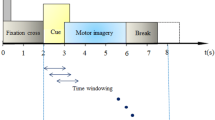Abstract
Brain-Computer Interface is aimed as a direct communication pathway between human or animal brain and an external device. A reliable, accurate and fast identification of a being’s intention based on EEG signal scanning is crucial part of the system. To improve the classification accuracy we propose to use Independent Component Analysis for \(\mu \)-rhythm identification in data corresponding to motor imagery task performance during Brain-Computer Interface training and operation. We show that independent components corresponding to the \(\mu \)-rhythm allow for higher classification accuracy comparing to raw EEG recordings usage.
Access this chapter
Tax calculation will be finalised at checkout
Purchases are for personal use only
Similar content being viewed by others
References
Broy, M.: Software engineering—from auxilary to key technologies. In: Broy, M., Dener, E. (eds.) Software Pioneers, p. 13. Springer, Heidelberg (2002)
Blankertz, B., Dornhege, G., Krauledat, M., Muller, K., Curio, G.: The non-invasive Berlin brain-computer interface: fast acquisition of effective performance in untrained subjects. NeuroImage 37, 539–550 (2007)
Bobrov, P., Frolov, A., Cantor, C., Fedulova, I., Bakhnyan, M.: brain-computer interface based on generation of visual images. PLoS ONE 6(6), e20674 (2011). doi:10.1371/journal.pone.0020674
Delorme, A., Makeig, S.: EEGLAB: An open source toolbox for analysis of single-trial EEG dynamics including independent component analysis. J. Neurosci. Methods 134, 9–21 (2004)
Frolov, A., Husek, D., Bobrov, P.: Comparison of four classification methods for brain computer interface. Neural Netw. World 21(2), 101–192 (2011)
Hyvarinen, A., Karhunen, J., Oje, E.: Independent component analysis. Willey, New York. pp.480 (2001)
Kachenoura, A., Albera, L., Senhadji, L., Comon, P.: ICA: a potential tool for BCI systems. IEEE Signal Process. Mag. 25(1), 57–68 (2008)
Makeig, S., Bell, A.J., Jung, T.-P., Sejnowski, T.J.: In: Touretzky, D., Mozer, M., Hasselmo, M. (eds.) Advances in neural information processing systems vol.8, pp.145–151. MIT Press, Cambridge, (1996)
Neuper, C., Scherer, R., Wriessnegger, S., Pfurtscheller, G.: Motor imagery and action observation: modulation of sensorimotor brain rhythms during mental control of a braincomputer interface. Clin. Neurophysiol. 120, 239–247 (2009)
Pfurtscheller, G.: EEG event-related de-synchronization (ERD) and event related synchronization (ERS). In: Niedermeyer, E., Lopes da Silva, F.H. (eds.) Electroencephalography: basic principles, clinical applications and related fields, 4th edn. pp. 958–967 . Williams and Wilkins.Baltimore, (1999)
Acknowledgments
This paper has been partly elaborated in the framework of the IT4Innovations Centre of Excellence project, reg. no. CZ.1.05/1.1.00/02.0070, supported by Operational Programme ‘Research and Development for Innovations’ funded by Structural Funds of the European Union and state budget of the Czech Republic and partly supported by the projects AV0Z10300504, GACR P202/10/0262, 205/09/1079.
Author information
Authors and Affiliations
Corresponding author
Editor information
Editors and Affiliations
Rights and permissions
Copyright information
© 2013 Springer-Verlag Berlin Heidelberg
About this paper
Cite this paper
Bobrov, P., Frolov, A.A., Húsek, D. (2013). Brain Computer Interface Enhancement by Independent Component Analysis. In: Kudělka, M., Pokorný, J., Snášel, V., Abraham, A. (eds) Proceedings of the Third International Conference on Intelligent Human Computer Interaction (IHCI 2011), Prague, Czech Republic, August, 2011. Advances in Intelligent Systems and Computing, vol 179. Springer, Berlin, Heidelberg. https://doi.org/10.1007/978-3-642-31603-6_5
Download citation
DOI: https://doi.org/10.1007/978-3-642-31603-6_5
Published:
Publisher Name: Springer, Berlin, Heidelberg
Print ISBN: 978-3-642-31602-9
Online ISBN: 978-3-642-31603-6
eBook Packages: EngineeringEngineering (R0)




